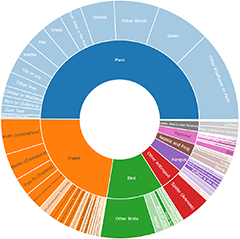Bees (Hymenoptera, Apiformes)
An introduction to Australian Native Bees can be found here:
https://www.aussiebee.com.au/beesinyourarea.html
The identification of bees from photographs can be difficult as tiny details on the animals have to be seen. Michael Batley, our moderator for bees has begun a trial identification tool for bees. The test groups are Megachilid bees and Hylaeine bees found in the Sydney basin and Blue Mountains.
If you want to try the identification tools, the addresses for the two groups are below:-
Announcements
There are currently no announcements.
Discussion
Curiosity
wrote:
8 Oct 2025
Nice sighting, @Snows! A female with good detail of the structure on her hind legs for collecting pollen.
Tetragonula carbonaria
PeterA
wrote:
29 Sep 2025
Second look - the dull thorax, dark legs and mark on T1 make L. hemichalceum more likely.
Lasioglossum (Chilalictus) hemichalceum
KylieWaldon
wrote:
27 Sep 2025
wow. that is so interesting MichaelM. They are so much bigger than most of the native bees that when I see them together they just seem to come in a push the native ones out of the way. But whether the native bees would polinate fruit trees or veggies I don't know, and I do like fruit and veg. Kylie TY :)
Apis mellifera
Significant sightings
- Xylocopa (Lestis) aerata at Acton, ACT
- Xylocopa (Lestis) aerata at Acton, ACT
- Leioproctus (Andrenopsis) wilsoni at Bruce, ACT
- Xylocopa (Lestis) aerata at Yarralumla, ACT
- Hylaeus (Euprosopoides) perplexus at Murrumbateman, NSW
- Megachile (Rhodomegachile) deanii at Acton, ACT
- Xylocopa (Lestis) aerata at Acton, ACT
- Xylocopa (Lestis) aerata at Theodore, ACT
- Xylocopa (Lestis) aerata at Acton, ACT
- Xylocopa (Lestis) aerata at Gundaroo, NSW
Top contributors
- kasiaaus 343
- AlisonMilton 260
- KylieWaldon 246
- PeterA 235
- TimL 227
- Roger 191
- HelenCross 163
- Hejor1 139
- LisaH 128
- RodDeb 123
Top moderators
- michael.batley 2.9K
- PeterA 941
- MichaelMulvaney 392
- DiBickers 257
- MichaelBedingfield 255
- donhe 43
- KimPullen 21
- Curiosity 16
- abread111 9
- CharlesDove 9






























































